How we achieved energy savings in lighting and developed more energy with a luxmeter
The human eye is a unique tool. He distinguishes thousands of colors and shades, distinguishes the brightness and saturation of colors. But, like any tool, it is designed to work in certain conditions. For example, working in the twilight for the eyes is not very comfortable and even harmful. And polar explorers without special glasses simply go blind on the amount of light reflected from the snow. In the SI system, the luminance measurement unit, Lux , was adopted, after which it became possible to measure this parameter. In order not to go into details, I’ll just say that there is a device that lets you know at a glance whether the eyes will be strained in the twilight and whether or not to add or reduce light - this is a light meter. We tested it indoors and outdoors, with various artificial and natural light sources, and the result was under the cut.
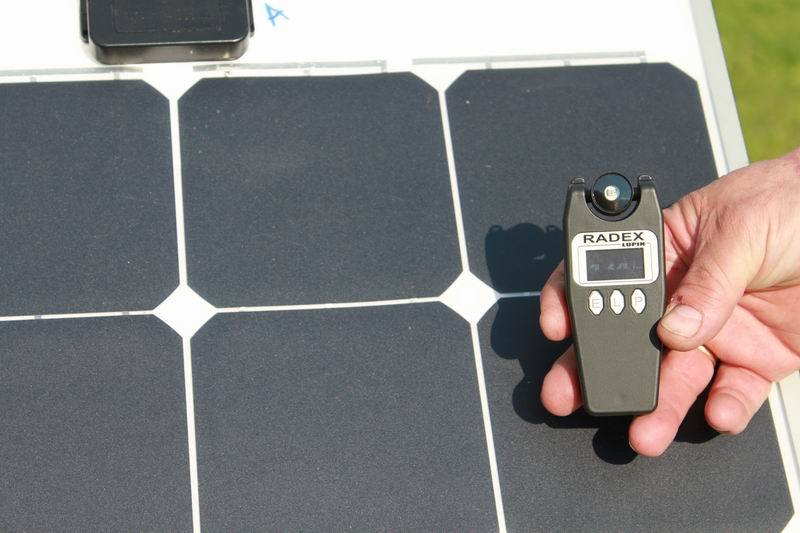
')
It began with the fact that not very common, but quite interesting device - a luxmeter fell into my hands. As can be seen from the first photo, it is quite compact, but at the same time functional. Main tasks: measurement of illumination, luminous flux and pulsation of a light source.
These are the basic parameters that you need to know for the organization of the workplace or your living space. I think that almost everyone noticed the flickering of long fluorescent lamps - it is especially well seen with side vision. Eyes get tired, fatigue grows, vision deteriorates. Need to change something.
We get a luxmeter out of the box. The package includes the device itself, a USB-microUSB cable and a charger with USB output.

Under the monochrome display there are only three buttons that include the corresponding measurement mode. The device turns off automatically after 70 seconds of downtime.
Button "E" - measurement of light. Lux unit, lx
The “L” button is a measurement of the brightness emitted by the light source. Cd / m2 unit
Button "P" - measurement of the pulsation of light. Unit of measurement %
In this case, the measurement rules should be followed: Illuminance is measured directly at the object. That is, you need to put the device on the table and press E. To measure the brightness of the lamp, you need to press the sensor to the light source, and if the object is hot (for example, incandescent lamp), then place it at the closest distance. Pulsation is measured in the same way as brightness measurement.
For example, these are the values I got on my desktop.
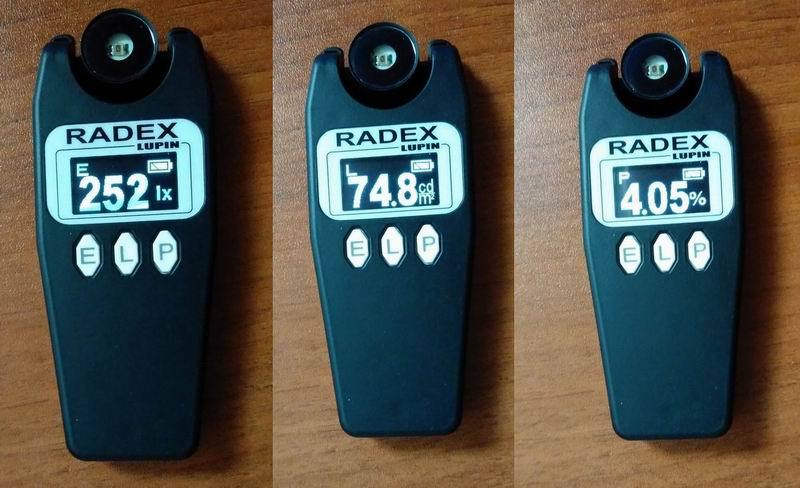
It is clear that the most reliable parameter here is illumination. Now let us turn to the norms of SANPIN, which stipulate the level of illumination in various rooms.
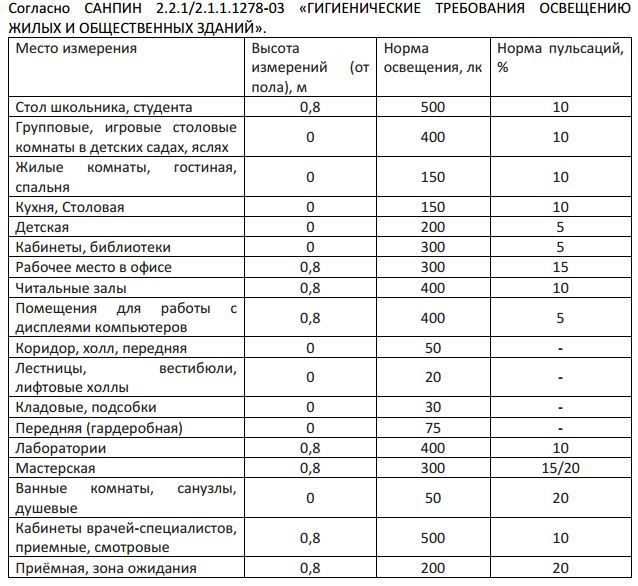
As you can see, the readings of the device almost fit into the norm, and all because any measurements must be averaged. Moreover, measurements should be taken not only at different working hours, but even at different times of the year. But I do not feel any discomfort at the workplace, since we have thick shutters and good artificial lighting.
But at work we spend up to a third of our time, but what about the house? Here we should carefully select the sources of light. Two other buttons will be useful for this. And going into the store of lamps and lamps, you should take the device with you. For example, new, but poor-quality, LED lamps can flicker with low frequency, which will lead to quick fatigue. And the lack of light in the room leads to a depressed state. In this case, the general level of illumination may be lower, and the local lamp can significantly improve the situation. For my smart home project, I also used this luxmeter as a reference and even described the process of adjusting the light in this material.

Sellers often cunning, pointing at the box with the lamp brightness, in relation to incandescent bulbs.
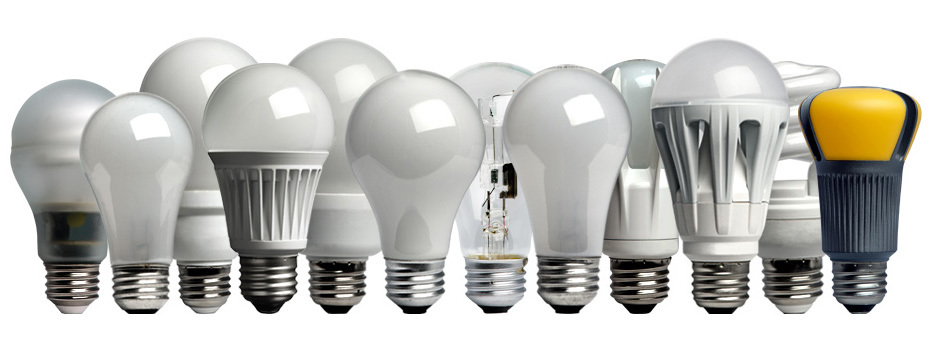
I suggest that you take the table below and compare it with what the sellers are offering to make sure that the seller has 100 watts, they are very different from the standard 100 watt incandescent lamp.
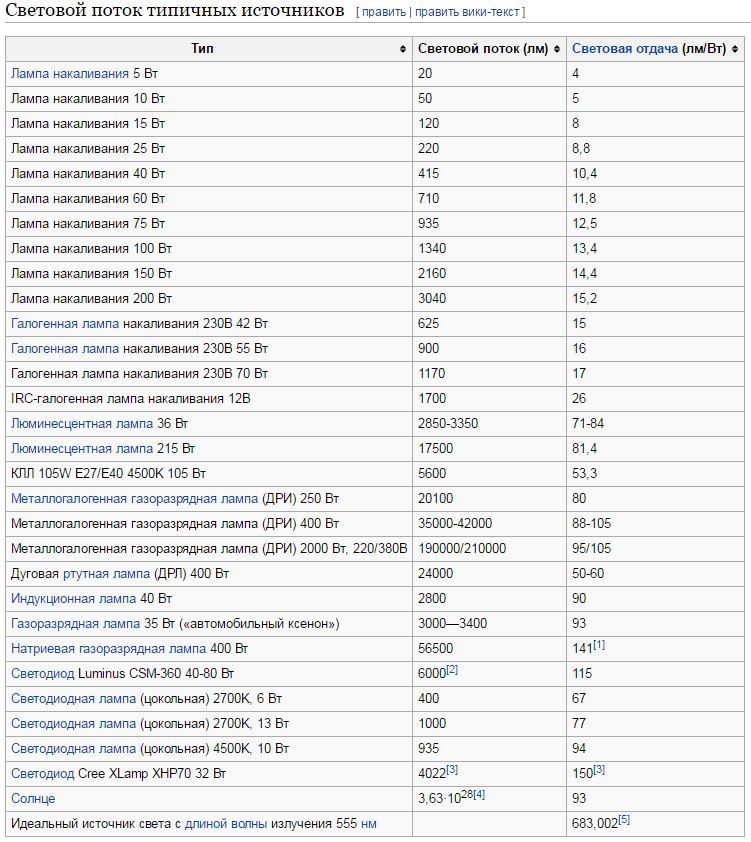
Well, this device was useful to me, not only for measuring the illumination in the workplace and at home, but also to get more energy. Explain clearly. Having recently left for nature, we took with us a mobile solar power plant from the company Mikroart, which I wrote about earlier . This is such an alternative to the ever-screaming generator at summer residents.
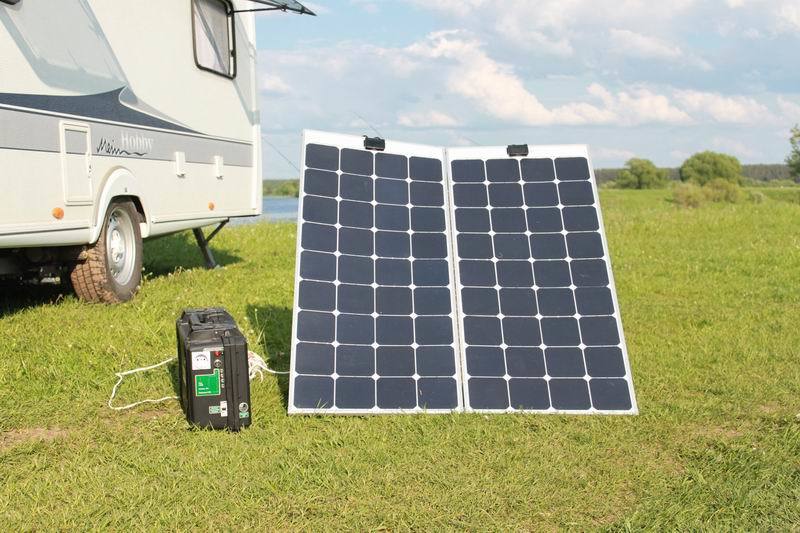
The peculiarity of the production of energy from the sun is that we get the maximum energy when the solar panels are located perpendicular to the rays of the sun. By eye, this can be done only approximately. Solar panels, installed permanently on the roof of the house, cannot be rotated behind the sun, and with this mobile station we quietly achieved maximum output by simply turning the solar panels in place and applying a light meter to the panels. As soon as we found the maximum value, we stopped our search for maximum output. In principle, it is enough to do this procedure several times a day in order to have enough energy for all our needs.
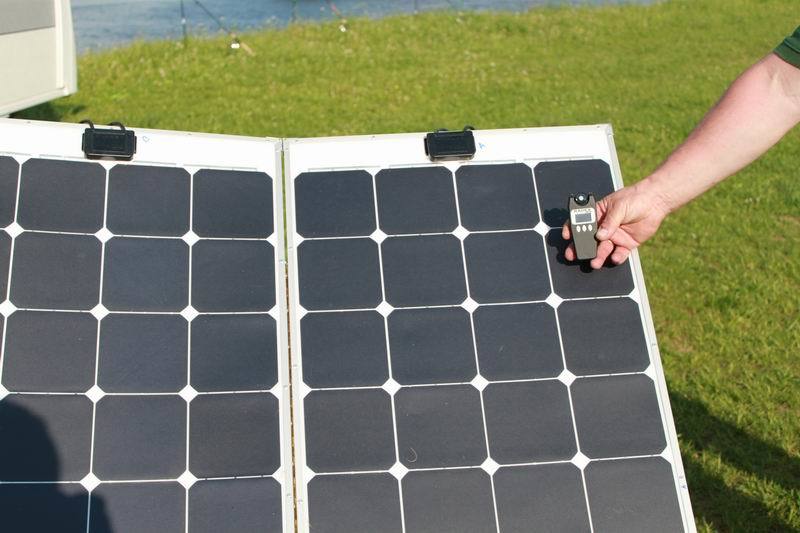
What we have not tried yet is connecting to a computer to obtain complete information about the measured light flux, its amplitude, shape and frequency. For this there is a special utility that is available on the store's website. It is useful when a comprehensive survey of a large number of premises is performed, but I just did not have such a need. The interface is simple and straightforward.
Work at the computer
I specifically singled out this paragraph in a separate section, as very few people are not sitting in front of the computer right now. A wrong setting of the monitor leads to quick fatigue and visual impairment. Further just I will give recommendations of measurements and settings from the instruction.
When measuring the brightness of monitors should display a blank white field. Monitor brightness measurements are carried out at 5 points - in every corner and in the middle of the screen. In addition to the brightness for monitors, the parameter “uneven brightness of the working area of the display” is also normalized - that is, the measured brightness values at different points of the monitor screen should not differ by more than 20%. You should pay special attention to the level of pulsation of monitor brightness - it should not exceed 5%. Basically, the level of ripple brightness of the monitor depends on the displayed brightness of the image on the screen. At intermediate levels of brightness of the image, the pulsations are usually maximum. To reduce the level of ripple brightness of the monitor is recommended to set the brightness level to the maximum level. If this results in an uncomfortable level of brightness, then you can try to reduce it with the color gamut settings.
I decided to check the screen of the monitor and the phone without preliminary settings - exactly as this technique works by default. And that's what happened.
Conclusion
I liked the device. I really used it in controversial situations and for real measurement of illumination in the room. It is compact, lightweight, holds a charge of more than 7 hours of complete work. The rotary head with the sensor allows you to comfortably receive data from the lamps and at the same time see the screen. Only once I ran into a problem: in the bright sun the screen literally blinds and you have to close it with your hand, creating a shadow. The rest of the device did not fail even once and worked as it should be.
Readers of the site have the opportunity to purchase " Luxometer - brightness meter - RADEX LUPIN pulse meter " with a 10% discount, using the GEEKT-RADEX code, which is valid 14 days from the date of publication of this article.
')
It began with the fact that not very common, but quite interesting device - a luxmeter fell into my hands. As can be seen from the first photo, it is quite compact, but at the same time functional. Main tasks: measurement of illumination, luminous flux and pulsation of a light source.
These are the basic parameters that you need to know for the organization of the workplace or your living space. I think that almost everyone noticed the flickering of long fluorescent lamps - it is especially well seen with side vision. Eyes get tired, fatigue grows, vision deteriorates. Need to change something.
We get a luxmeter out of the box. The package includes the device itself, a USB-microUSB cable and a charger with USB output.

Under the monochrome display there are only three buttons that include the corresponding measurement mode. The device turns off automatically after 70 seconds of downtime.
Button "E" - measurement of light. Lux unit, lx
The “L” button is a measurement of the brightness emitted by the light source. Cd / m2 unit
Button "P" - measurement of the pulsation of light. Unit of measurement %
In this case, the measurement rules should be followed: Illuminance is measured directly at the object. That is, you need to put the device on the table and press E. To measure the brightness of the lamp, you need to press the sensor to the light source, and if the object is hot (for example, incandescent lamp), then place it at the closest distance. Pulsation is measured in the same way as brightness measurement.
For example, these are the values I got on my desktop.

It is clear that the most reliable parameter here is illumination. Now let us turn to the norms of SANPIN, which stipulate the level of illumination in various rooms.
As you can see, the readings of the device almost fit into the norm, and all because any measurements must be averaged. Moreover, measurements should be taken not only at different working hours, but even at different times of the year. But I do not feel any discomfort at the workplace, since we have thick shutters and good artificial lighting.
But at work we spend up to a third of our time, but what about the house? Here we should carefully select the sources of light. Two other buttons will be useful for this. And going into the store of lamps and lamps, you should take the device with you. For example, new, but poor-quality, LED lamps can flicker with low frequency, which will lead to quick fatigue. And the lack of light in the room leads to a depressed state. In this case, the general level of illumination may be lower, and the local lamp can significantly improve the situation. For my smart home project, I also used this luxmeter as a reference and even described the process of adjusting the light in this material.
Sellers often cunning, pointing at the box with the lamp brightness, in relation to incandescent bulbs.

I suggest that you take the table below and compare it with what the sellers are offering to make sure that the seller has 100 watts, they are very different from the standard 100 watt incandescent lamp.
Well, this device was useful to me, not only for measuring the illumination in the workplace and at home, but also to get more energy. Explain clearly. Having recently left for nature, we took with us a mobile solar power plant from the company Mikroart, which I wrote about earlier . This is such an alternative to the ever-screaming generator at summer residents.
The peculiarity of the production of energy from the sun is that we get the maximum energy when the solar panels are located perpendicular to the rays of the sun. By eye, this can be done only approximately. Solar panels, installed permanently on the roof of the house, cannot be rotated behind the sun, and with this mobile station we quietly achieved maximum output by simply turning the solar panels in place and applying a light meter to the panels. As soon as we found the maximum value, we stopped our search for maximum output. In principle, it is enough to do this procedure several times a day in order to have enough energy for all our needs.
What we have not tried yet is connecting to a computer to obtain complete information about the measured light flux, its amplitude, shape and frequency. For this there is a special utility that is available on the store's website. It is useful when a comprehensive survey of a large number of premises is performed, but I just did not have such a need. The interface is simple and straightforward.
Work at the computer
I specifically singled out this paragraph in a separate section, as very few people are not sitting in front of the computer right now. A wrong setting of the monitor leads to quick fatigue and visual impairment. Further just I will give recommendations of measurements and settings from the instruction.
When measuring the brightness of monitors should display a blank white field. Monitor brightness measurements are carried out at 5 points - in every corner and in the middle of the screen. In addition to the brightness for monitors, the parameter “uneven brightness of the working area of the display” is also normalized - that is, the measured brightness values at different points of the monitor screen should not differ by more than 20%. You should pay special attention to the level of pulsation of monitor brightness - it should not exceed 5%. Basically, the level of ripple brightness of the monitor depends on the displayed brightness of the image on the screen. At intermediate levels of brightness of the image, the pulsations are usually maximum. To reduce the level of ripple brightness of the monitor is recommended to set the brightness level to the maximum level. If this results in an uncomfortable level of brightness, then you can try to reduce it with the color gamut settings.
I decided to check the screen of the monitor and the phone without preliminary settings - exactly as this technique works by default. And that's what happened.
Conclusion
I liked the device. I really used it in controversial situations and for real measurement of illumination in the room. It is compact, lightweight, holds a charge of more than 7 hours of complete work. The rotary head with the sensor allows you to comfortably receive data from the lamps and at the same time see the screen. Only once I ran into a problem: in the bright sun the screen literally blinds and you have to close it with your hand, creating a shadow. The rest of the device did not fail even once and worked as it should be.
Readers of the site have the opportunity to purchase " Luxometer - brightness meter - RADEX LUPIN pulse meter " with a 10% discount, using the GEEKT-RADEX code, which is valid 14 days from the date of publication of this article.
Source: https://habr.com/ru/post/394583/
All Articles